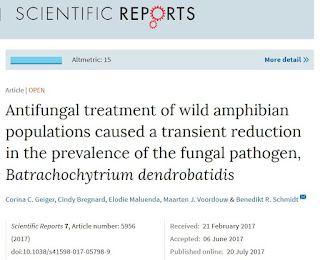In a new paper published in Scientific Reports (link), Corina Geiger and coauthors describe the results of a field experiments on Bd mitigation. They show that a transient reduction of prevalence is possible.
Here's the abstract:
"Emerging infectious diseases can drive host populations to extinction and are a major driver of biodiversity loss. Controlling diseases and mitigating their impacts is therefore a priority for conservation science and practice. Chytridiomycosis is a devastating disease of amphibians that is caused by the fungal pathogen Batrachochytrium dendrobatidis (Bd), and for which there is an urgent need to develop mitigation methods. We treated tadpoles of the common midwife toad (Alytes obstetricans) with antifungal agents using a capture-treat-release approach in the field. Antifungal treatment during the spring reduced the prevalence of Bd in the cohort of tadpoles that had overwintered and reduced transmission of Bd from this cohort to the uninfected young-of-the-year cohort. Unfortunately, the mitigation was only transient, and the antifungal treatment was unable to prevent the rapid spread of Bd through the young-of-the year cohort. During the winter, Bd prevalence reached 100% in both the control and treated ponds. In the following spring, no effects of treatment were detectable anymore. We conclude that the sporadic application of antifungal agents in the present study was not sufficient for the long-term and large-scale control of Bd in this amphibian system."
Tuesday, 1 August 2017
Subscribe to:
Posts (Atom)
